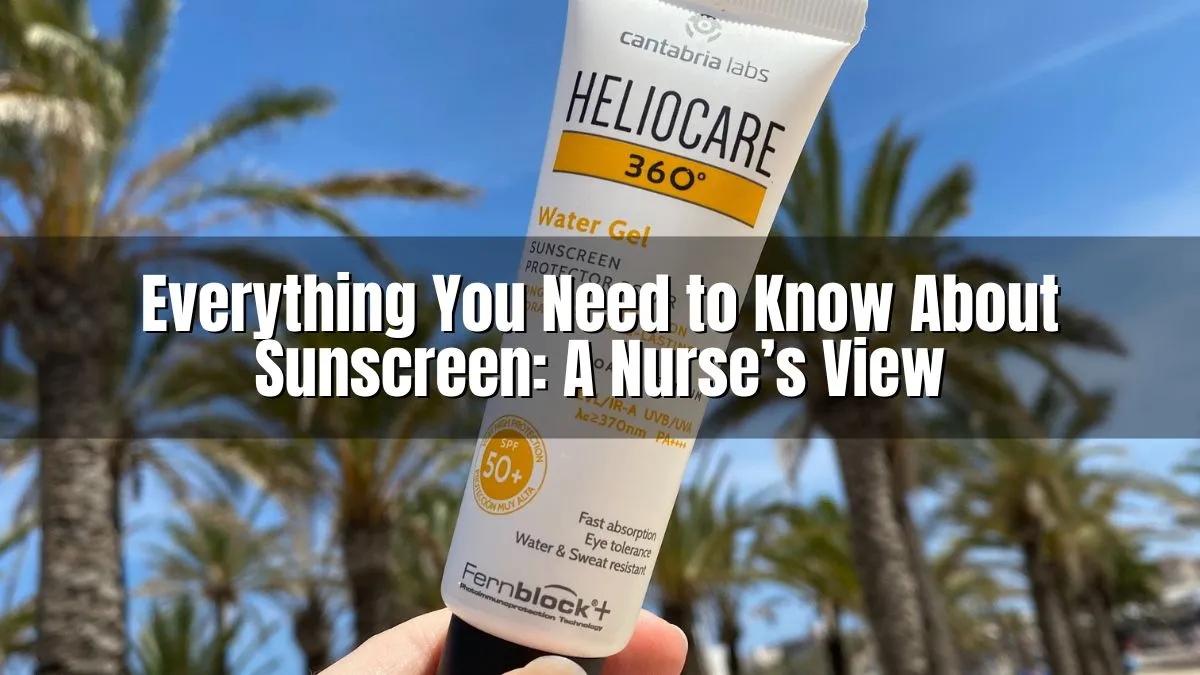Everything You Need to Know About Sunscreen: A Nurse’s View

A practical guide to sunscreen essentials, application tips, and expert advice from a nurse’s perspective.
Sunscreen is one of the most essential components of any skincare routine. In the UK, where the weather is often overcast, the long-term effects of UV radiation are frequently overlooked. UVA and UVB rays, known for their harmful effects on the skin, are present throughout the entire year.
Table of Contents
ToggleAt DA Aesthetics in Buckinghamshire, we emphasise sun protection not only for its cosmetic benefits, but for the role it plays in maintaining skin health, reducing premature ageing, and supporting recovery after non-surgical cosmetic treatments.
Why Is Sunscreen So Important in the UK?
UVA rays can still reach your skin even on cloudy days, as they pass through clouds and glass. These rays are primarily responsible for photoageing, contributing to fine lines, uneven pigmentation, and collagen breakdown. UVB rays are less intense in the UK than in equatorial regions, but they can still lead to sunburn and increase the risk of skin cancers.
Sunscreen offers an accessible and reliable way to reduce this cumulative damage and preserve skin quality over time.
Physical vs Chemical Sunscreens
There are two main categories of sunscreen filters:
Physical (Mineral) Sunscreens
-
-
- Use zinc oxide or titanium dioxide
- Reflect UV rays
- Well-tolerated by sensitive or post-treatment skin
- May leave a visible cast on deeper skin tones
- Use zinc oxide or titanium dioxide
-
Chemical Sunscreens
-
-
- Contain ingredients like avobenzone or octinoxate
- Absorb UV rays and convert them to heat
- Often lighter in texture and cosmetically elegant
- May be unsuitable for sensitive or allergy-prone skin
- Contain ingredients like avobenzone or octinoxate
-
Modern sunscreens often blend both types of filters to offer balanced protection and a pleasant texture.
Broad-Spectrum and SPF Explained
A good sunscreen should be broad-spectrum, meaning it protects against both UVA and UVB rays. SPF only refers to protection against UVB.
For daily wear, SPF 30 or higher is recommended in the UK. Look for products that include UVA ratings as well, such as a UVA circle logo or Boots star rating to ensure comprehensive coverage.
How Much Sunscreen Should You Use?
Most people apply far less sunscreen than is needed for effective protection.
To cover the face and neck, use the two-finger rule: dispense a line of sunscreen the length of your index and middle fingers. This equates to roughly 0.5ml—the recommended volume to match SPF testing conditions.
For the entire body, approximately 35ml to 40ml is recommended—about the size of a shot glass. Reapply every two hours if you’re outdoors, and after swimming, sweating, or towel drying.
Sunscreen After Aesthetic Treatments
After treatments such as microneedling, peels, or injectable procedures, the skin becomes temporarily more vulnerable to UV damage. Unprotected exposure can lead to hyperpigmentation, delayed healing, and inflammation.
At DA Aesthetics, we always include SPF as part of our post-treatment protocol. We advise using mineral-based, non-irritating formulations during recovery periods to maintain results and protect the skin barrier.
Why I Recommend Heliocare
Heliocare 360° is a clinically developed sunscreen range offering protection from:
-
-
- UVA and UVB rays
- Visible light (HEV)
- Infrared A (IR-A)
- UVA and UVB rays
-
What sets Heliocare apart is its use of Fernblock®+, a patented extract with antioxidant and DNA-repairing properties. This adds a layer of cellular defence, making it highly suitable for sensitive skin and post-procedure care.
Available Heliocare Products at DA Aesthetics
We offer a range of Heliocare 360° sunscreens at the clinic, including:
-
-
- Heliocare 360° Gel Oil-Free SPF 50 – Suitable for oily or acne-prone skin
- Heliocare 360° Mineral Tolerance Fluid SPF 50 – A great choice for delicate or recently treated skin.
- Heliocare 360° Pigment Solution Fluid SPF 50+ – For clients concerned about pigmentation
- Heliocare 360° Tinted Gel Oil-Free SPF 50+ – Offers sheer coverage with broad-spectrum sun defence.
- Heliocare Oral Supplements – To support sun protection internally (used alongside topical SPF, not as a replacement)
- Heliocare 360° Gel Oil-Free SPF 50 – Suitable for oily or acne-prone skin
-
If you’re unsure which product suits your skin type or treatment plan, this can be discussed during your consultation.
Why Sunscreen Matters at DA Aesthetics
At DA Aesthetics, sun protection is not an afterthought—it’s a foundational part of your long-term skin strategy. We don’t just hand you a product; we explain why it matters, how to apply it correctly, and which formulation supports your skin’s needs at different stages.
Whether you’re managing pigmentation, undergoing aesthetic treatments, or simply wanting to maintain healthy skin, sunscreen is always included in the conversation—because prevention is as important as treatment.
Frequently Asked Questions (FAQs)
Yes, UVA exposure stays constant regardless of the season and can pass through both clouds and glass. Sunscreen should be worn daily, regardless of visible sunlight.
Yes, especially if you’re outdoors. Reapply sunscreen every two hours—or sooner if you’ve been swimming, sweating, or drying off with a towel.
Yes, although sunscreens made for the face are usually more lightweight and cosmetically elegant. You may prefer a formulation like Heliocare 360° Gel Oil-Free for the face, and a separate product for the body.
Mineral-based sunscreens, such as Heliocare 360° Mineral Tolerance Fluid, are suitable after skin treatments due to their gentler formulation.
No. The oral supplements are designed to enhance your skin’s defences but are not a substitute for topical sunscreen. They are best used together for extended outdoor exposure.